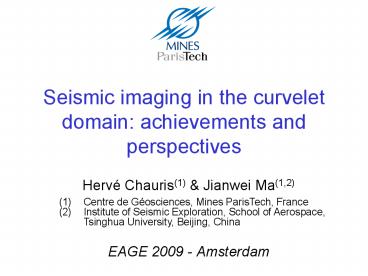Seismic imaging in the curvelet domain: achievements and perspectives - PowerPoint PPT Presentation
1 / 26
Title:
Seismic imaging in the curvelet domain: achievements and perspectives
Description:
seismic demigration/migration velocity estimation. Conclusions ... Demigration/migration. Sensitivity of the migrated result with respect to the velocity ... – PowerPoint PPT presentation
Number of Views:250
Avg rating:3.0/5.0
Title: Seismic imaging in the curvelet domain: achievements and perspectives
1
Seismic imaging in the curvelet domain
achievements and perspectives
- Hervé Chauris(1) Jianwei Ma(1,2)
- EAGE 2009 - Amsterdam
- Centre de Géosciences, Mines ParisTech, France
- Institute of Seismic Exploration, School of
Aerospace, Tsinghua University, Beijing, China
2
Locally coherent events
Time common-offset section
Same section after depth migration
3
Locally coherent events
- Context seismic modeling / migration
Diffraction point
Globally coherent event
Locally coherent event
4
Curvelets and other lets
Taking into account band-limited data ?
Curvelet
Ridgelet
Contourlet
Shearlet
Wavelet
EPW
Surfacelet
Seislet
Bandlet,
5
Potential of curvelets
Single curvelet
Seismic data
6
Introduction Curvelets
Curvelets for different coefficients cµ(x,z)
shift
stretch
rotation
7
Content
- Introduction what are curvelets
- Curvelets and seismic processing tasks
- pre-/post-processing
- seismic migration
- seismic demigration/migration velocity
estimation - Conclusions
8
Curvelets and seismic applications
- Review
- Ma and Plonka, 2009
- Workshop EAGE 2007 (London), Chauris and Douma
- Data denoising, interpolation and compression
- Hennenfent and Herrmann, 2006 Droujinine et al.,
2007 - Herrmann et al., 2008a Sacchi et al., 2007
- Herrmann et al., 2008b Fomel, 2007
- Lin and Herrmann, 2007
- Neelamani et al, 2008
- Seismic modeling and migration
- Douma and de Hoop, 2007
- Chauris, 2006
- Velocity model estimation
- Chauris and Nguyen, 2007
- Chauris and Nguyen, 2008
redundant transform
9
Seismic propagation/migration
- Theoretical results
- Candes and Donoho, 2003
- Practical results
- Douma and de Hoop, 2006
- Douma and de Hoop, 2007
- Chauris, 2006
10
Use of digital curvelets
Fast curvelet transform
Migrated section in initial model
Curvelet processing
Fast inverse curvelet transform
Perturbed section
11
Migration in heterogeneous models
Smooth heterogeneous 2-D model
Kirchhoff migration
First-order curvelet migration
12
Migration in heterogeneous models
First-order curvelet migration
Kirchhoff migration
13
Migration in heterogeneous models
First-order approximation not good enough
14
Demigration/migration
Sensitivity of the migrated result with respect
to the velocity model
Initial velocity model
Triplicated ray field
Velocity perturbation (up to 200 m/s)
15
Demigration/migration
- Sensitivity of a migrated image with respect to
the background velocity model
Given velocity model
Migration
?
Local velocity perturbation
Migration
16
Input data
RayBorn 2-D synthetic data set (offsets from 0
to 2 km)
Offset 600 m
Initial image
17
Demigration/migration
Sensitivity of the migrated result with respect
to the velocity model
18
Demigration/migration
Depth difference reduced from 60 m to less than 2
m
Initial / exact
Predicted / exact
19
Demigration/migration
Sensitivity of the migrated result with respect
to the velocity model
Unperturbed part
Modified part
20
Common Image Gathers
The prediction takes into account the lateral
velocity variations
Prediction with curvelets
Exact
Reference image
21
Demigration/migration
- Sensitivity of a migrated image with respect to
the background velocity model
Given velocity model
Migration
?
Local velocity perturbation
Migration
22
Velocity estimation
- Sensitivity of a migrated image with respect to
the background velocity model
Given velocity model
Migration
Improved seismic section
?
Optimal velocity perturbation?
Migration
Cost function
23
DSO in curvelet domain
Feasibility study 2-D synthetic rayBorn data set
Initial
After 1 iteration
Exact
24
DSO in curvelet domain
Stack of offsets between 100 and 800 m
Initial
After 1 iteration
Exact
25
Conclusions perspectives
- Seismic imaging operators
- Curvelets more suited for demigration/migration
than for migration or demigration (modeling)
alone - Applications limited to smooth background
velocity models - A similar analysis should be conducted for
(non-smooth) general background velocity models
(without the use of geometrical optics) - Perspectives new transform (e.g. with explicit
curvature)?
26
Acknowledgements
We would like to thank F. ten Kroode (Shell
EP) for fruitful discussions and support M.
Noble and P. Podvin (Mines ParisTech) Shell
EP for partly funding the project































